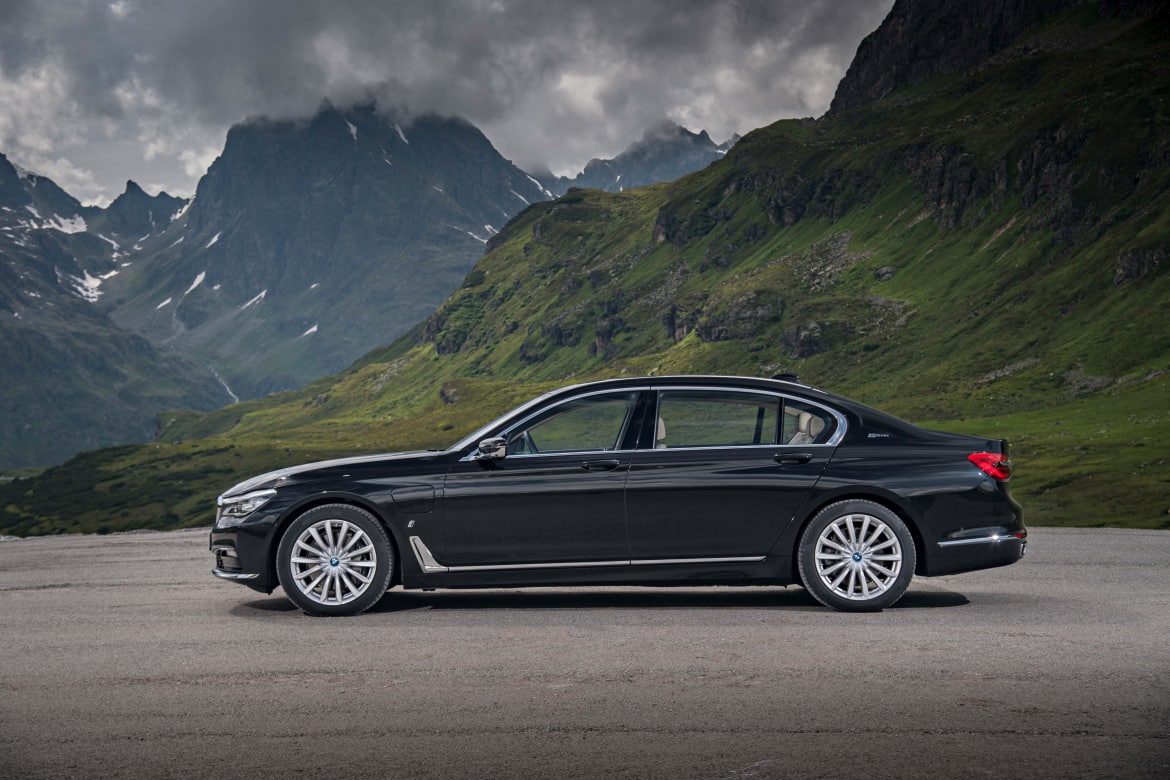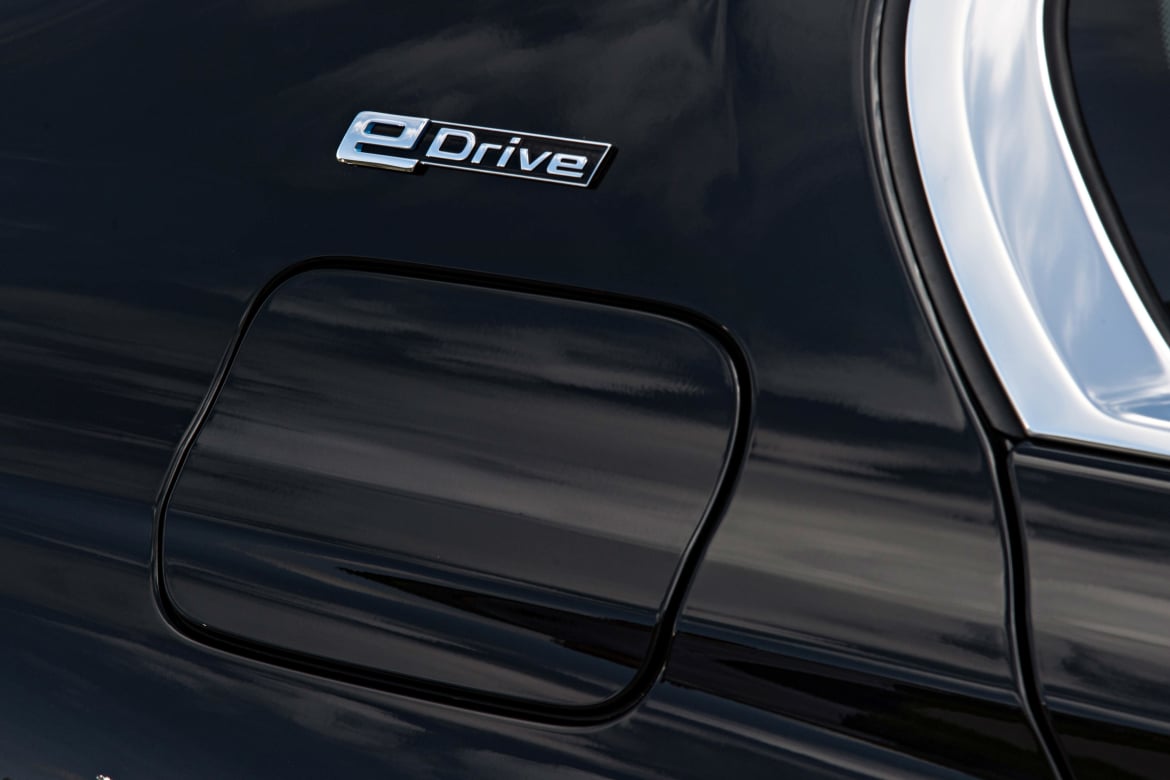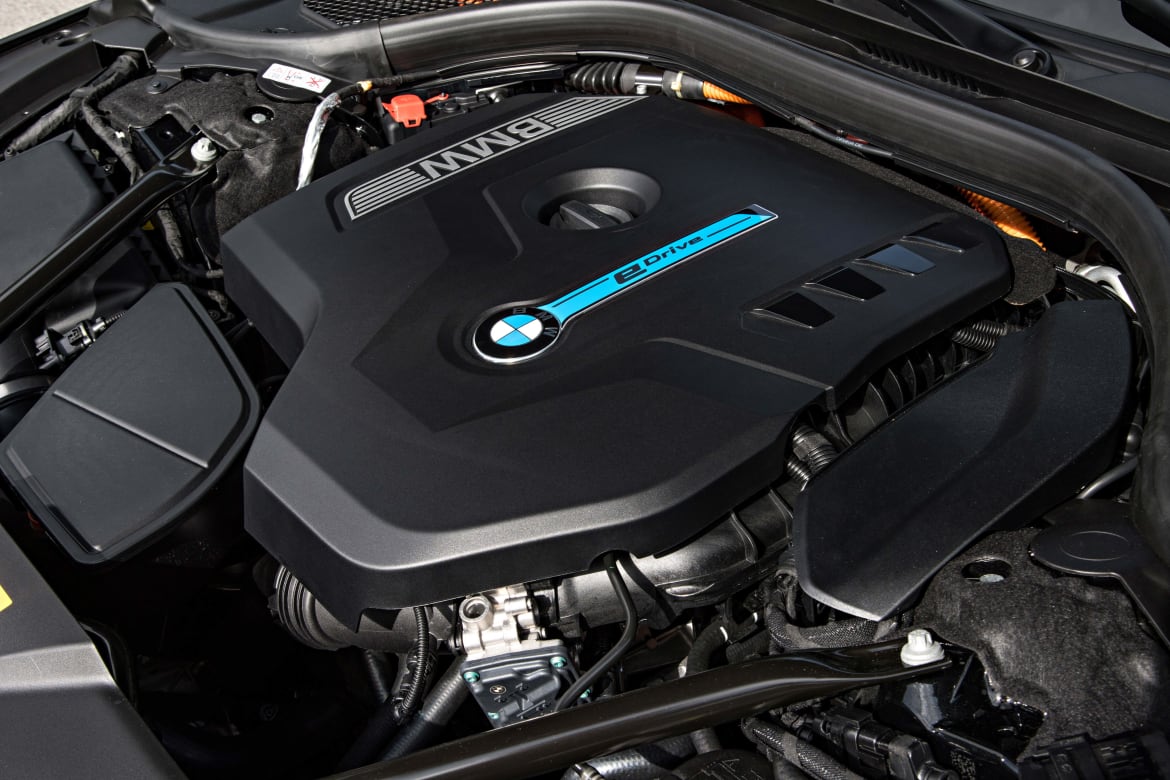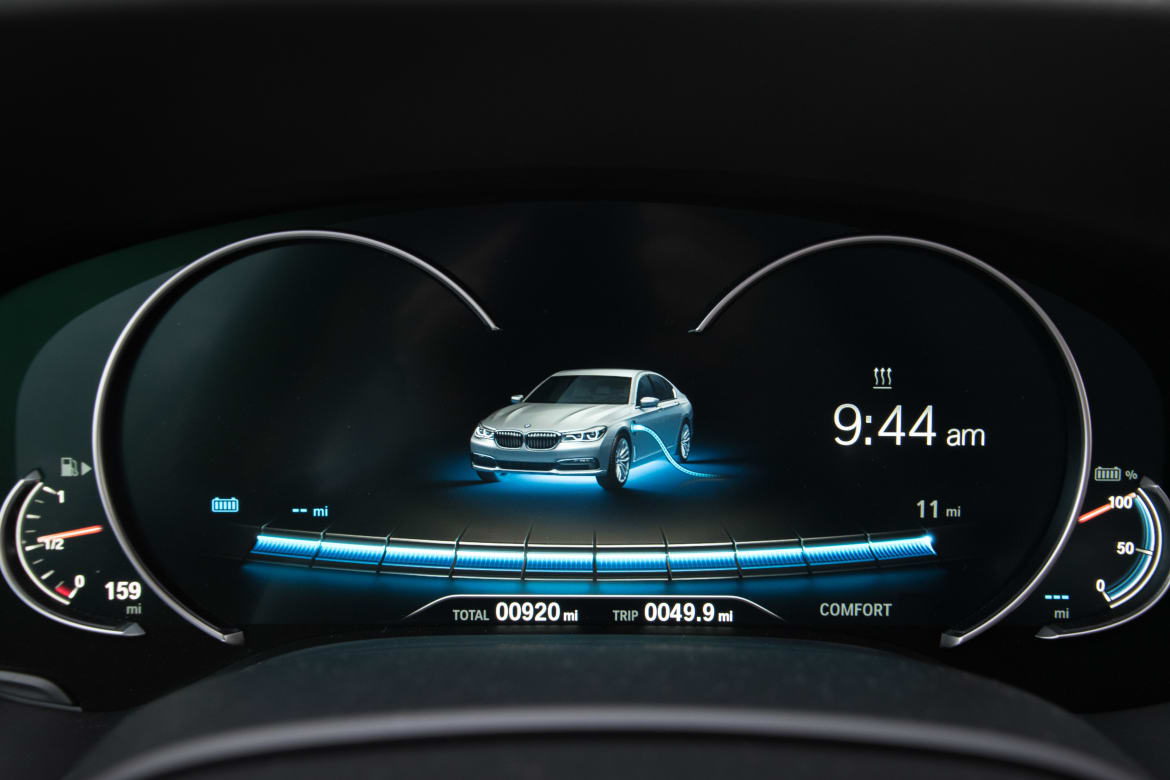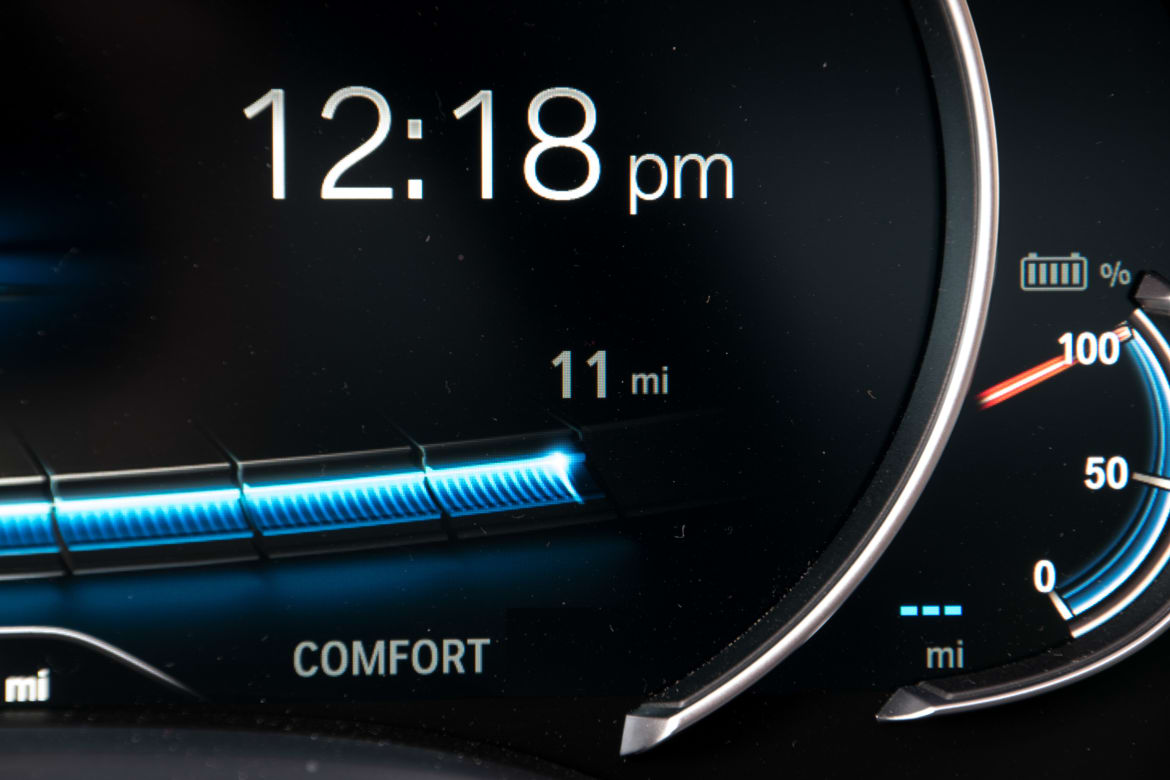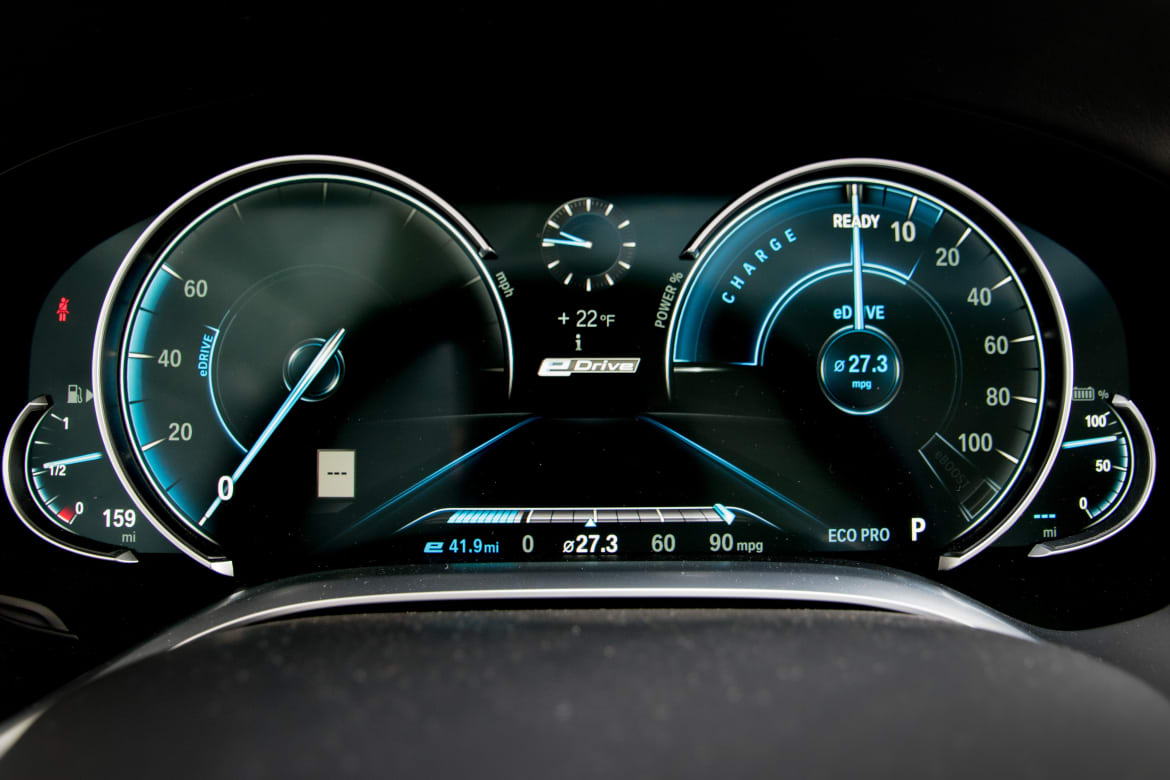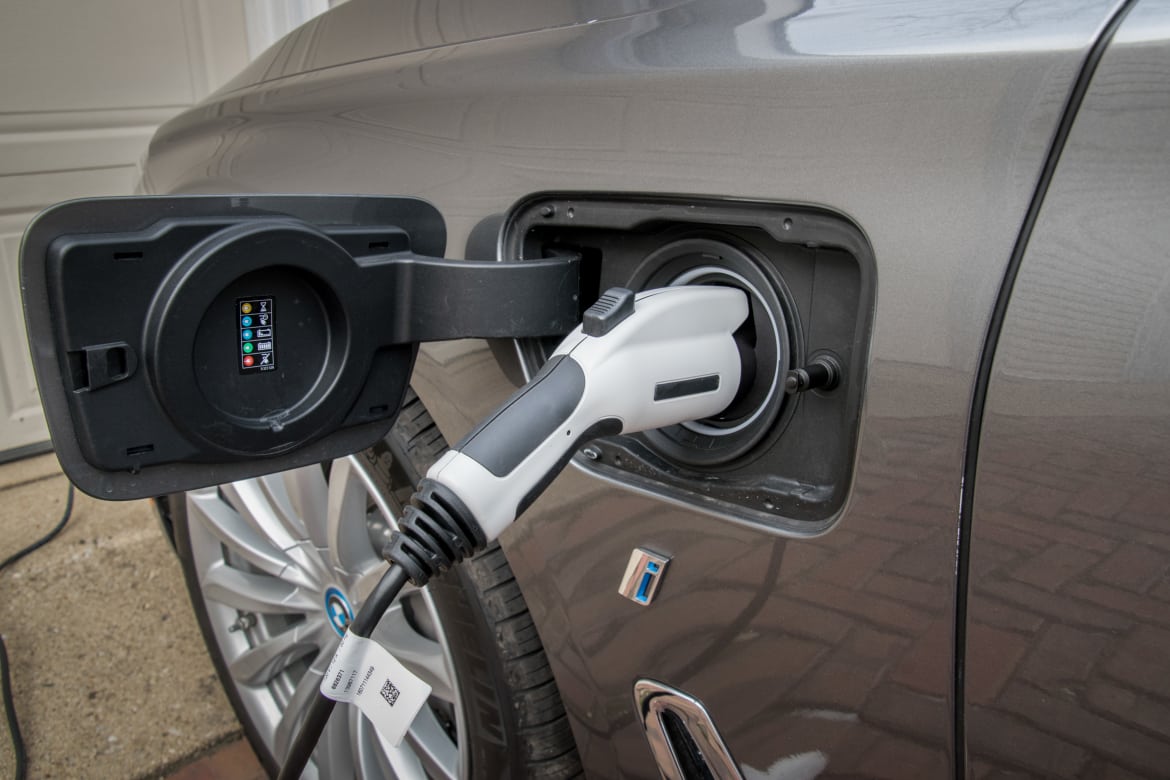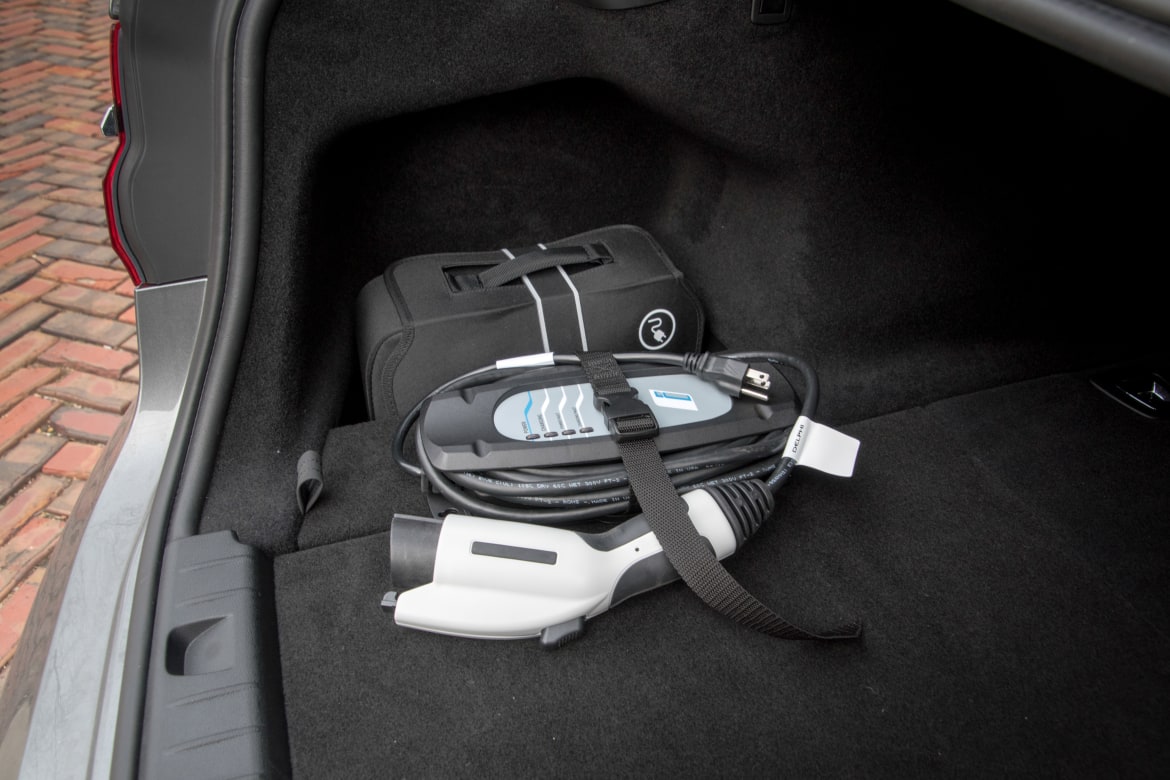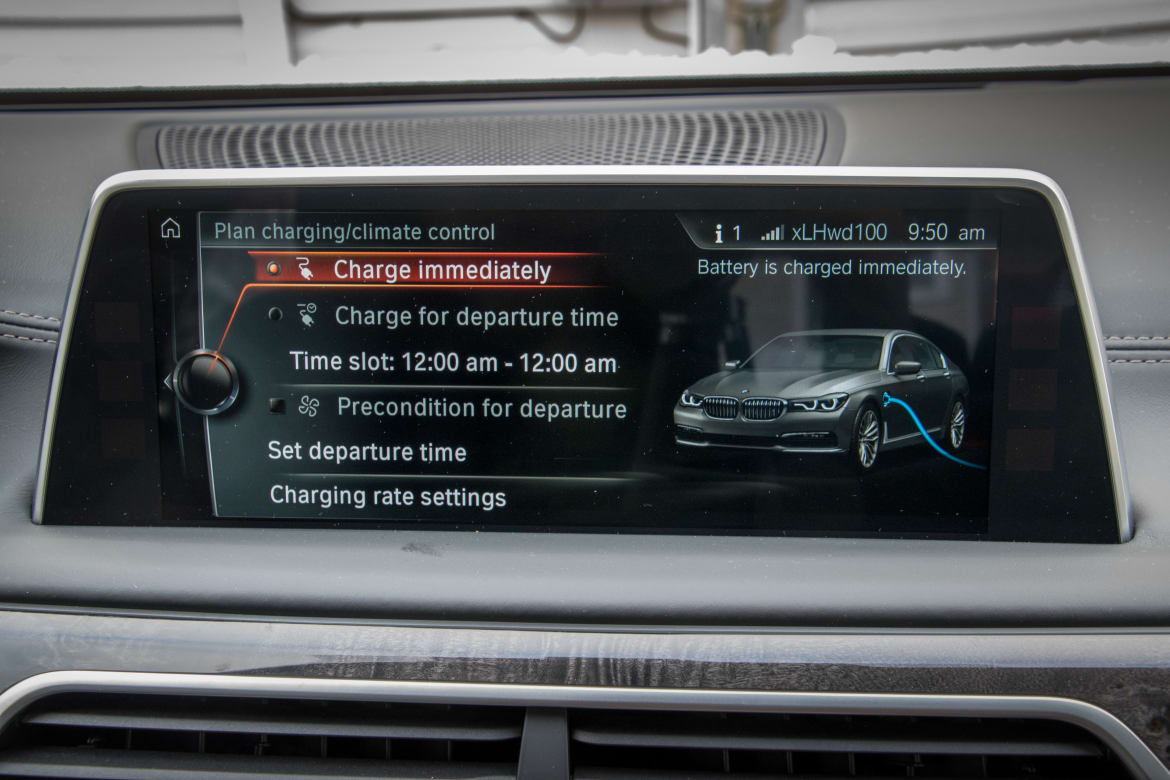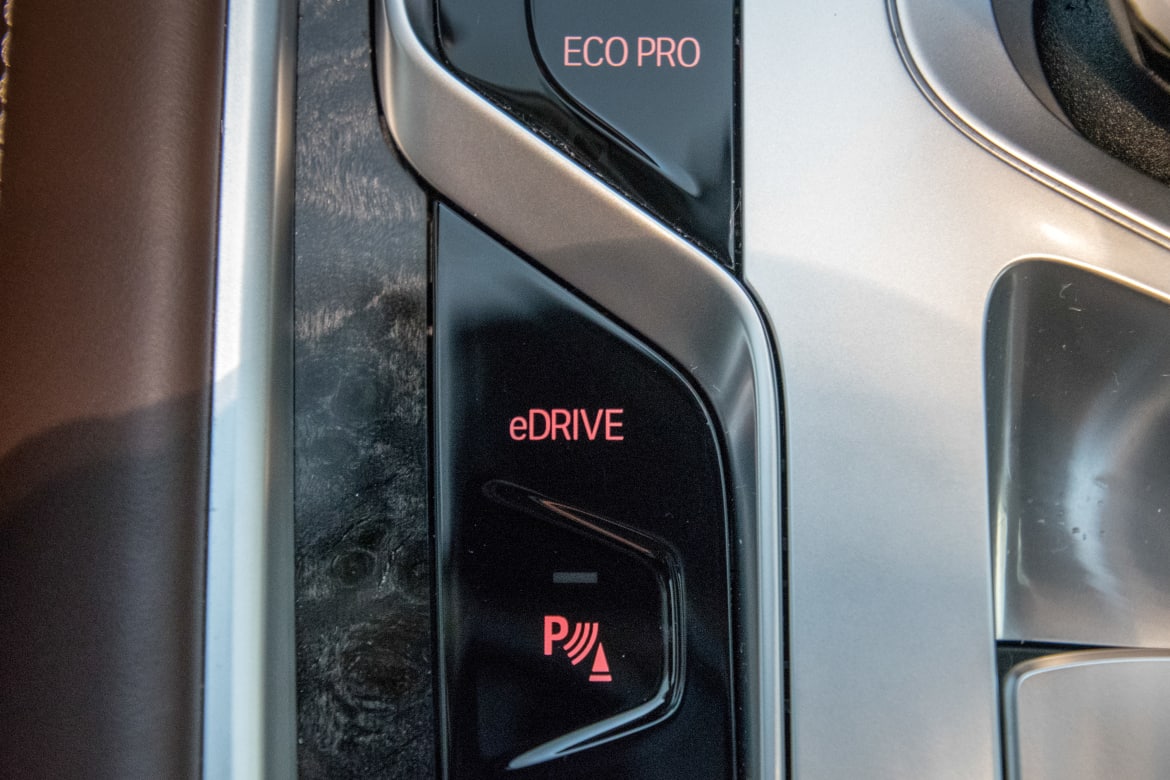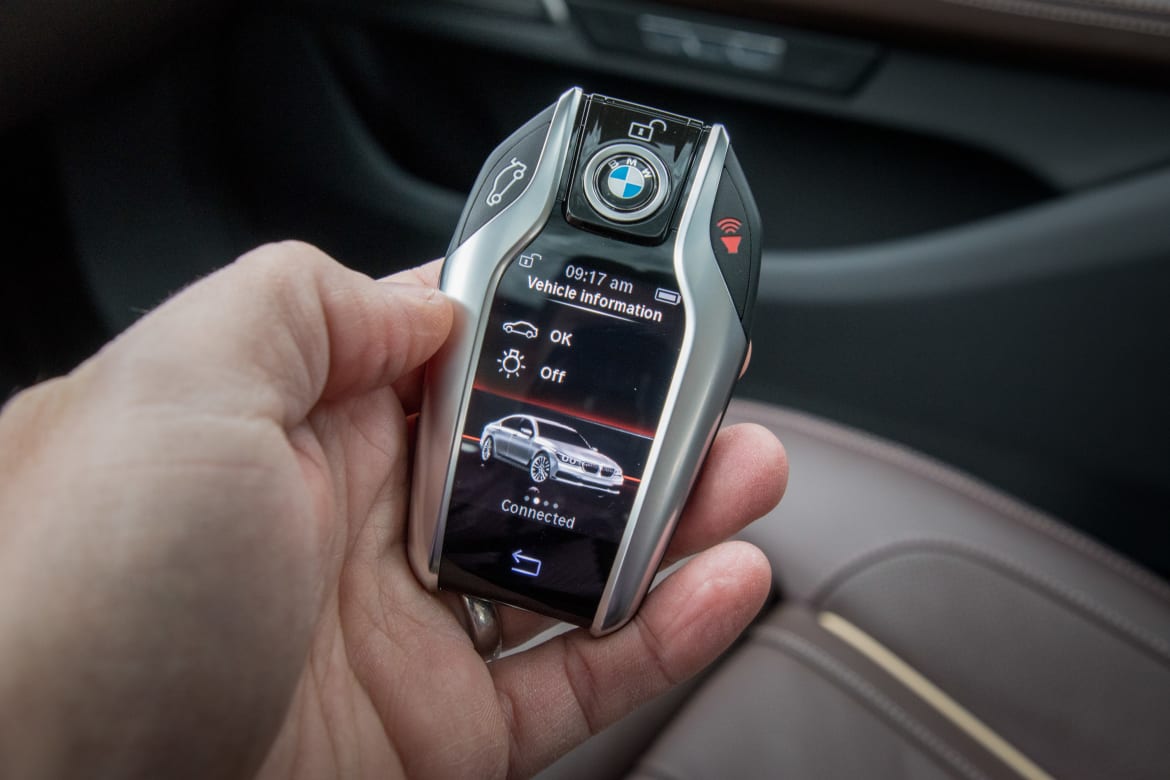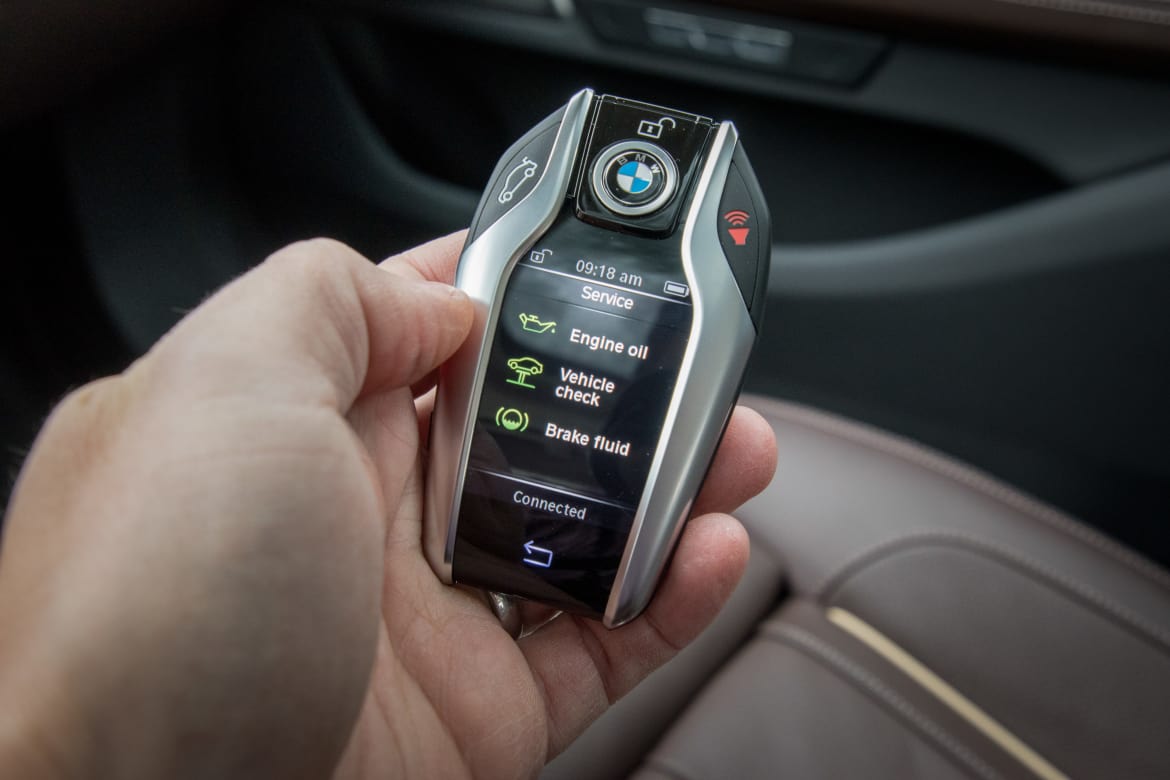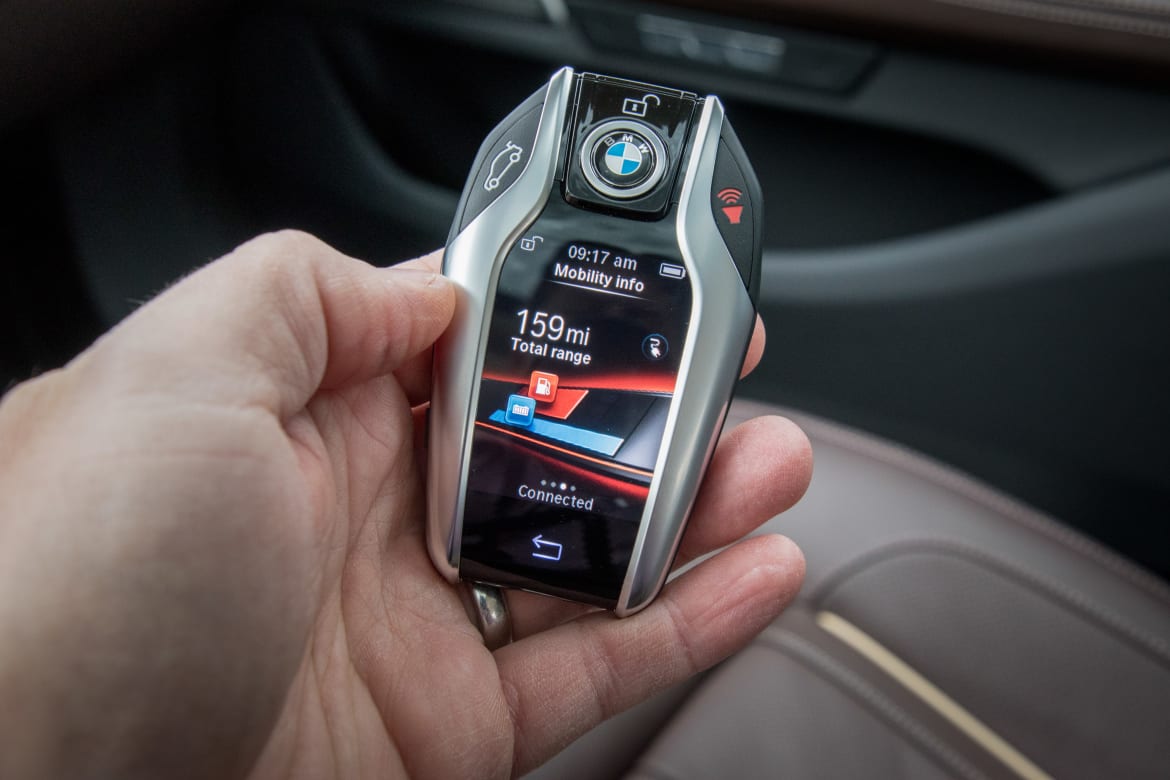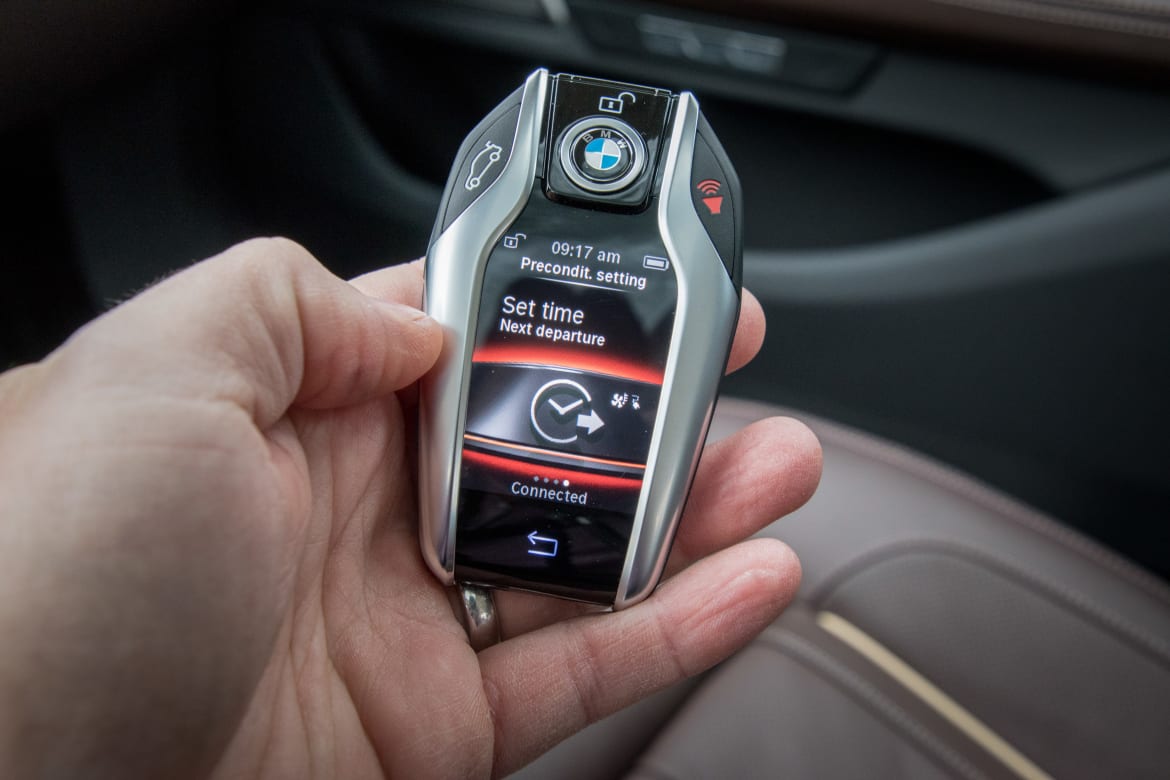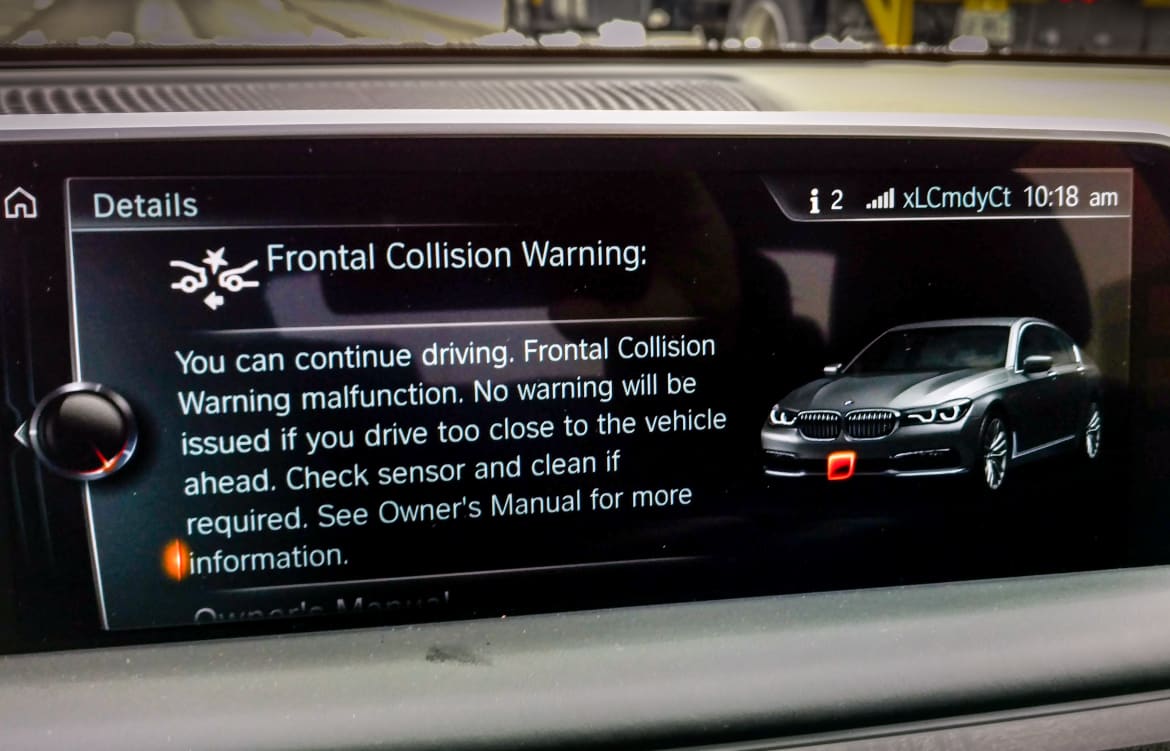Despite being comparably equipped (and priced) to a gas-only model, the new plug-in hybrid 7 Series fails the cost-benefit test.
The plug-in hybrid electric version is officially named the 740e xDrive iPerformance, where the “e” represents electric; “xDrive” is BMW’s general name for all-wheel drive, which is standard here. The “i” in iPerformance associates the car with BMW’s more ambitious plug-in cars, the i3 and i8. Unfortunately, “i” is also the designation for gas-only models like the 740i and 750i, but it’s best not to dwell on automotive naming “standards,” lest you hurt your brain.
The 740e plug-in hybrid starts at $90,095 (all prices cited include destination charges) but is eligible for a federal tax credit of $4,668. This prices it $2,932 above the gas-only 740i ($82,495) and more than $10,000 cheaper than the 750i ($95,595), both of which have standard rear-wheel drive. For a closer comparison, however, all-wheel drive adds $3,000 to non-hybrid models, so the price is practically even between the 740e and the 740i xDrive, and the gap grows to $13,168 between the plug-in and the 750i xDrive ($98,595).
I’ll let our 750i review stand and focus here primarily on the 740e’s plug-in hybrid attributes and those of comparable models like the 2017 Mercedes-Benz S550e and 2018 Porsche Panamera 4 E-Hybrid (see the BMW and Mercedes compared side-by-side; Porsche data are not yet available).
Exterior & Styling
The 740e is nearly indistinguishable from gas-only versions of the car but for a few eDrive badges, “i” logos and an “i Blue” accent color on the grille and wheels. Plus the charge-port door on the driver’s side front fender looks like an oversized fuel-filler door.
How It Drives
For a hybrid, the 740e drives pretty nicely. The transition from electric to gas/electric acceleration is smooth and, thanks to a conventional eight-speed automatic transmission, the 740e feels more like a normal car than many hybrids do; it steps up through gears as it gains speed rather than emitting a consistent engine drone. The brakes have the unmistakable mushy, nonlinear feel common to hybrid regeneration, but it’s far from the worst we’ve experienced.
The all-wheel drive isn’t as interesting, technologically, as that in the i8, which drives the front wheels electrically and the rear ones with a gas engine — called a through-the-road hybrid design. The 740e’s electric motor and turbocharged 2.0-liter four-cylinder gas engine work together under the hood to power conventional all-wheel drive. The results are what matter, though, and the AWD performed very well for me, traversing streets blanketed with wet snow without any drama.
The transition from electric to gas/electric acceleration is smooth and, thanks to a conventional eight-speed automatic transmission, the 740e feels more like a normal car than many hybrids do.
The car is quick. With combined gas/electric power of 332 horsepower, it bests the 322 hp of the 740i’s turbocharged 3.0-liter inline-six-cylinder engine. Ditto the zero-to-60 mph time: 5.1 seconds versus the rear-drive 740i’s 5.4 seconds, according to BMW. Added traction shaves the 740i xDrive’s time to an even match at 5.1 seconds. For comparison, the 750i’s turbocharged, 4.4-liter V-8 generates 443 hp, which propels both the RWD and AWD versions to 60 mph in an estimated 4.6 and 4.3 seconds, respectively.
One plug-in competitor, the 2017 Mercedes S550e, matches the 740e closely, reaching 60 mph in 5.2 seconds, per the manufacturer. It comes only with rear-wheel drive. Replacing the earlier generation, which also hit 60 mph in 5.2 seconds, the all-wheel-drive 2018 Panamera 4 E-Hybrid does it in a claimed 4.4 seconds with optional equipment.
One downside to the 740e powertrain is how it sounds: like a four-cylinder. It’s not exceptionally loud, but when you do hear it, the coarse sound doesn’t befit a flagship luxury sedan.
Once you get past the hybrid aspect and into the plug-in portion of the 740e, things stop making much sense. The premise behind plug-in hybrids is that you depart with a full battery that’s charged with cheap electricity. Regular hybrids charge their batteries using the gas engine (inefficient) and through regenerative braking that uses the car’s inertia to turn a motor/generator (efficient). Plug-in hybrids operate the same way once they’re under way, but in order to justify the plug-in aspect, those hybrids need to have a decent electric-only range to put a dent in the gas consumption of, say, a commute or any other driving one does before the next charge. What’s a decent electric range? Definitely more than 14 miles, which is the 740e’s EPA estimate.
The 740e compares in this regard to the S550e (14 miles) and also to first-generation PHEVs like the Toyota Prius Plug-In (11 miles) and the retired 2016 Panamera S E-Hybrid (16 miles). In its second generation, the 2017 Prius Prime is up to an estimated 25 miles. There’s no U.S. range estimate for the Porsche, but the more lenient European test suggests it could be above 20 miles using the EPA’s more realistic test regimen. Even the 2017 Chrysler Pacifica minivan promises 33 miles. Range-extended electric cars — PHEVs of a type — the 2017 Chevrolet Volt and BMW’s own 2017 i3 with range extender go 53 and 97 miles, respectively, before switching to gas backup.
In actual use, my 740e’s instrument panel never showed more than 12 miles of range after charging, likely because outside temperatures were in the 20s — a common downside for plug-ins. I wish I could verify the range, but the car usually refused to activate the Max eDrive mode, which would ensure electric-only operation up to 87 mph, again probably because of the cold. Instead I got the mixed electric/gas mode. Even though I remote-preconditioned the cabin, using household power to prevent sapping the battery, the initial range estimate would vanish when I started the car and not reappear until many miles had passed and the car was warmer. It seemed like I wasn’t getting my full 12 miles under any circumstances.
Fortunately, the hybrid system improves mileage even without a charge: The 740e gets an EPA-estimated 27 mpg combined, versus 24 or 22 mpg for the 740i with rear- or all-wheel drive, respectively, on premium gas. The S550e delivers 26 mpg versus 21 or 20 mpg for the gas-only S550 RWD or AWD, respectively. The 2018 Panamera had not been rated as of publication.
There are two charging options: the included Occasional Use Cable that plugs into a standard household 120-volt outlet, or any Level 2 (240-volt) charging system. Those start above $500 from various suppliers — excluding installation, which can cost anywhere from $100 to many thousands, depending on the layout of your home. The Occasional Use Cable should fill a depleted battery pack in less than 7 hours, which can work if your car is always parked overnight. Level 2 knocks the time down to less than 3 hours, according to BMW. These rates aren’t great, revealing the challenges of electrifying a large, heavy car. Battery-electric cars typically add 5 miles of range per hour of charging at 120 volts and 10-20 miles per hour at 240 volts. The 740e isn’t close. Many Level 2 systems are designed to charge faster than the 740e does, but the car’s 3.7-kilowatt onboard electronics are a bottleneck.
So what do you sacrifice for the limited upside of 14 miles of range and higher mpg? One thing is the size of the gas tank, which shrinks from 20.6 to 12.1 gallons. With that, the car’s estimated range drops from 494 miles per tankful in a 740i to 340 miles — including the estimated 14 miles you can go just on electricity.
For other shortcomings, read on.
Interior
The 740e has the same rich interior described in our 750i review, with no drawbacks. Unlike some hybrids, the 740e’s passenger volume remains the same as the other versions. And even though the gas engine sounds a bit low-rent under some circumstances, to some people the electric-only low-speed operation enhances the car’s luxury feel — especially if you can take advantage of all-electric eDrive acceleration up to highway speeds.
Ergonomics & Electronics
Despite its complexity, iDrive remains one of the easier car multimedia and control systems. The display is now a touchscreen, as well, but it’s not particularly close to occupants. In the 740e, it adds hybrid-specific pages like a power-flow diagram and adjustments for charging times and maintaining a configurable battery charge level.
This was our first exposure to the Display Key, which is standard with the 740e. It’s a remote the size of a flip phone, with a color touchscreen along with the usual lock and unlock buttons. Its power can be replenished in the wireless smartphone charging pocket in the center console or with a micro USB cable. It drew lots of oohs and aahs, but once you explore it you’ll find its value is limited. It provides a percentage of charge on one screen and total range on another, but doesn’t specify electric range in miles. You can also use it to preheat or -cool the cabin before departing. (See photos.) But unless you have Remote Control Parking, which lets you stand outside and move the car forward or back (we didn’t), it doesn’t do anything you can’t accomplish with the BMW Connected app on a smartphone, which has unlimited range. BMW cites a range of almost 1,000 feet for Display Key.
For what it’s worth, our second exposure to gesture control (see video) also didn’t impress — though we like the idea. The system was too slow to register when I swirled my finger in the air, and once it did, the stereo’s volume jumped too quickly. Going back the other way to correct it only introduces another lag. The 740e also consistently recognized a gesture I wasn’t making: Every time I held my phone in my right hand, it thought I was giving the two-finger gesture, which can be configured to do one of a few things. The best I could do was set it to the least intrusive option or turn all gesture controls off entirely.
Cargo & Storage
Along with the fuel tank, the 740e’s trunk pays a price for the incorporated high-voltage battery pack, shrinking from 18.2 to 14.8 cubic feet. In practice, though, it seems roomier than the numbers suggest, being reasonably wide and long, with a large opening. The backseat center pass-through remains.
Safety
Expensive luxury sedans like the 7 Series aren’t normally crash-tested by the Insurance Institute for Highway Safety or the National Highway Traffic Safety Administration. In fact, IIHS has never published test results for the 7 Series.
A backup camera is standard and 360-degree cameras are optional. Two different Driver Assistance Plus option packages also provide active-safety and autonomous driving features, including blind spot warning, rear cross-traffic alert, lane departure warning and prevention, forward collision warning with automatic emergency braking and pedestrian detection, adaptive cruise control with stop-and-go capability, cross-traffic warning and traffic jam assistant.
With traffic jam assistant, you can press a button on the steering wheel and the 740e will steer itself to stay in its lane. The system had no trouble following highway lane markings on an overcast day and was better than average when driving into sunlight, a situation that has a tendency to trip up these kinds of systems. You have to keep at least one hand on the wheel, however, or the steering assistance will cease after about 10 seconds. An animated graphic at the bottom of the instrument panel directs you to take the wheel — a unique touch.
Night vision with pedestrian and animal detection costs $2,300. The system projects a black and white video image on the dashboard screen and highlights pedestrians and large animals in yellow when they’re present.
Value in Its Class
As stated, the 740e costs roughly the same as an all-wheel-drive 740i, which seems appropriate in this case. But even at this price, the plug-in hybrid 7 Series struggles to justify its existence. Perhaps its value rests overseas, where some city centers ban or heavily fine vehicles with internal combustion engines during peak hours to control pollution. With its Battery Control feature, which lets the driver maintain a charge level anywhere from 30 percent to 100 percent for later use, the 740e could presumably creep into and out of such a zone on electric power. But so far the U.S. doesn’t impose such restrictions.
Historically, PHEVs have been of interest to a very specific type of owner with a particular driving routine — which is to say not many buyers at all. Only now will we find out if significant demand even exists for these things as the second generation comes out with longer electric ranges. Sadly, the 740e doesn’t match this description.
Source:cars.com

